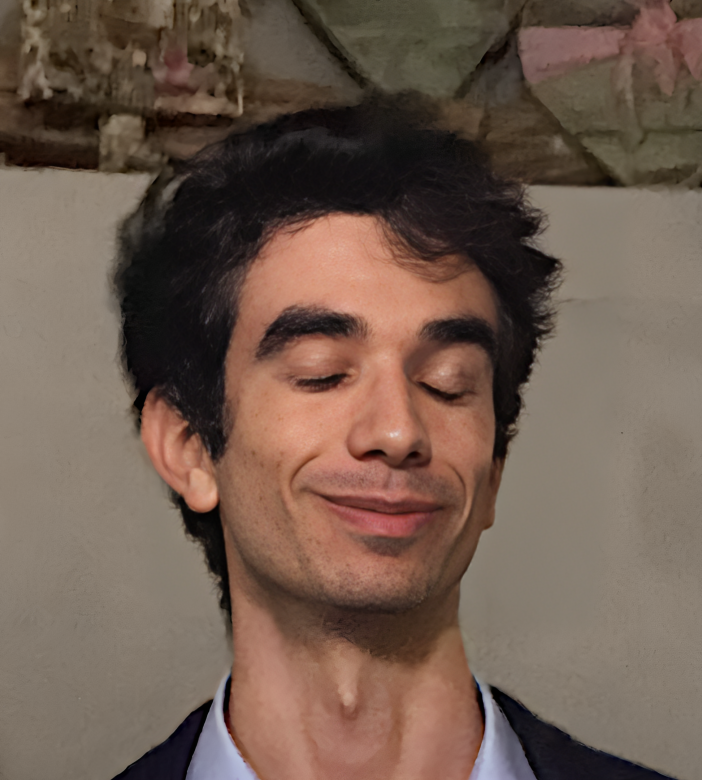About me
It's always about me, isn't it?Hi! I'm Filippo, 4th year student in mathematics at the University of Oxford, supervised by Marc Lackenby. On September 1st 2025, I will start a post‑doc at Trinity College Dublin.
I think about algorithmic problems on 3‑manifolds and, occasionally, on surfaces and groups.

When you read the first sentence on the Wikipedia page of "knot complement".When you prove the binomial theorem using the Künneth spectral sequence.When a 5‑dimensional topologist hands you a 5‑manifold and asks if it is homeomorphic to the 5‑sphere.When a 4‑dimensional topologist asks you if your 3‑manifold is triangulable.When a student asks you to explain what a category is without using the word "monad". When you read the first sentence on the Wikipedia page of "knot complement".
|
Recent articles
2024
Uniformly polynomial-time classification of surface homeomorphisms, accepted for publication in Mathematische Annalen, arXiv:2402.00231.
2024
In this paper, I show that the Nielsen-Thurston type of a mapping class (periodic, reducible, or pseudo-Anosov) can be decided in polynomial time in the word length.
"But this was already known from the work of Bell and Webb – Polynomial-time algorithms for the curve graph!", I (metaphorically) hear you say.
Excellent point, thank you for bringing it up.
The key difference is that the running time of my algorithm, unlike the one of Bell and Webb, is also polynomial in $\chi(S)$ – hence the word "uniform" in the title.
The argument relies on an unordinate amount of combinatorics of train tracks; the theoretical heavy-lifting is done by the work of Masur and Minsky on the geometry of the curve graph.
2024
Classification of genus-two surfaces in $S^3$, accepted for publication in Algebraic & Geometric Topology, arXiv:2309.05387.
2024
One of the fundamental problems in algorithmic 3-dimensional topology is the knot isotopy problem: given two knots in the 3-sphere, decide whether they are "the same knot".
In fact, this is arguably the problem that kickstarted the field of algorithmic 3-dimensional topology; it was essentially solved by Haken, using ideas from his (then) new theory of normal surfaces.
A natural generalisation leads us to consider – instead of knots, which are intrinsically genus-one objects – higher genus surfaces.
In this paper, I show that there is an algorithm to decide whether two genus-two surfaces in the 3-sphere are isotopic.
The algorithm is not particularly clever nor particularly elegant (also not particularly efficient); the only highlight is perhaps one of its building blocks, a new algorithm to solve a specific kind of equations in free groups.
The case of arbitrary genus is interesting and still open; notably, it appears as Problem 3.11 on Kirby's list.
2024
Solution of the Hurwitz problem with a length-2 partition (with Carlo Petronio), in Illinois Journal of Mathematics 68.3, pp. 479-511, arXiv:2305.06634.
2024
A branched covering $f:\tilde{\Sigma}\to\Sigma$ between closed surfaces (although people with a different background might refer to them as "curves", which has definitely led to some confusion in the past) contains some combinatorial information: for each branching point in $\Sigma$, record the multi-set of local degrees of $f$ at its pre-images in $\tilde{\Sigma}$.
Each of these multi-sets is a partition of the degree $d$ of $f$; call the collection of all these partitions the branching datum of $f$.
A branching datum will always satisfy an elementary condition given by the Riemann-Hurwitz formula.
Conversely, the Hurwitz existence problem asks which collections of partitions satisfying the Riemann-Hurwitz formula occur as branching data of some branched covering.
In this paper, we give a complete solution of this problem for collections with at least one partition of length 2.
The general setting remains wide open, with dozens of very special cases solved by various authors, but no unifying theory in sight.
This was my Master's thesis project, and my advisor Carlo Petronio was kind enough to help me turn it into a publishable article. As part of the project, I implemented a computer program to solve the Hurwitz problem for any fixed degree $d$ and number of partitions $n$ (see the paper for the link to the source code). I also ran this code for $n=3$ and $d\leq 29$, thus verifying the mysterious prime degree conjecture up to this degree.
This was my Master's thesis project, and my advisor Carlo Petronio was kind enough to help me turn it into a publishable article. As part of the project, I implemented a computer program to solve the Hurwitz problem for any fixed degree $d$ and number of partitions $n$ (see the paper for the link to the source code). I also ran this code for $n=3$ and $d\leq 29$, thus verifying the mysterious prime degree conjecture up to this degree.
Upcoming travel
30 Jun–4 Jul 25
Currently at: The William Rowan Hamilton Geometry and Topology Workshop: Celebrating Martin Bridson's 60th Birthday, Trinity College Dublin, Ireland.
8–13 Sept 25